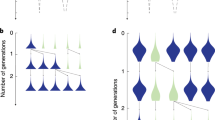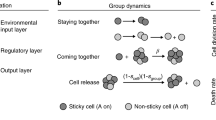Abstract
The evolution of multicellular organisms from unicellular ancestors involves a shift in the level at which selection operates. It is usual to think about this shift in terms of the emergence of traits that cause heritable differences in reproductive output at the level of nascent collectives. Defining these traits and the causes of their origin lies at the heart of understanding the evolution of multicellular life. In working toward a mechanistic, take-nothing-for-granted account, we begin by recognizing that the standard Lewontin formulation of properties necessary and sufficient for evolution by natural selection does not necessarily encompass Darwinian evolution in primitive collectives where parent-offspring relationships may have been poorly defined. This, we suggest, limits the ability to conceptualize and capture the earliest manifestations of Darwinian properties. By way of solution we propose a relaxed interpretation of Lewontin’s conditions and present these in the form of a set of necessary requirements for evolution by natural selection based upon the establishment of genealogical connections between recurrences of collectives. With emphasis on genealogy – as opposed to reproduction – it is possible to conceive selection acting on collectives prior to any manifestation of heritable variance in fitness. Such possibility draws attention to the evolutionary emergence of traits that strengthen causal relationships between recurrences – traits likely to underpin the emergence of forms of multiplication that establish parent-offspring relationships. Application of this framework to collectives of marginal status, particularly those whose recurrence is not defined by genealogy, makes clear that change at the level of collectives need not arise from selection acting at the higher level. We conclude by outlining applicability of our framework to loosely defined collectives of cells, such as those comprising the slugs of social amoeba and microbes that constitute the human microbiome.


Similar content being viewed by others
References
Baldauf SL 2003 The deep roots of eukaryotes. Science 300 1703–1706
Bonner JT 1974 On development: The biology of form (Harvard, MA: Harvard University Press)
Bonner JT 1998 The origins of multicellularity. Integr. Biol. 1 27–36
Bonner JT 2000 First signals: The evolution of multicellular development (Princeton: Princeton University Press)
Boraas ME, Seale DB and Boxhorn JE 1998 Phagotrophy by a flagellate selects for colonial prey: A possible origin of multicellularity. Evol. Ecol. 12 153–164
Bouchard F 2008 Causal processes, fitness, and the differential persistence of lineages. Phil. Sci. 75 560–570
Bouchard F and Huneman P (eds) 2013 From groups to individuals: Evolution and emerging individuality (Boston: MIT Press)
Bourrat P 2014a From survivors to replicators: evolution by natural selection revisited. Biol. Phil. doi:10.1007/s10539-013-9383-1
Bourrat P 2014b Levels of selection are artefacts of different temporal fitness measures. Ratio, in press.
Buss LW 1987 The evolution of individuality (Princeton: Princeton University Press)
Cho I and Blaser MJ 2012 The human microbiome: at the interface of health and disease. Nat. Rev. Genet. 13 260–270
Chuang JS, Rivoire O and Leibler S 2009 Simpson paradox in a synthetic microbial system. Science 323 272–275
Clarke E 2014 Origins of evolutionary transitions. J Biosci. 39. doi:10.1007/s12038-013-9375-y
Cramer J, Mebinger A and Frey E 2012 Growth dynamics and the evolution of cooperation in microbial populations. Sci. Rep. 2 281
Crespi BJ 2004 Vicious circles: positive feedback in major evolutionary and ecological transtions. Trends Ecol. Evol. 19 627–633
Garcia T and De Monte S 2013 Group formation and the evolution of sociality. Evolution 67 131–141
Garcia T, Gregory Brunnet L and De Monte S 2014 Differential adhesion between moving particles as a mechanism for the evolution of social groups. PLoS Comp. Biol., in press
Gardner A and Grafen A 2009 Capturing the superorganism: a formal theory of group adaptation. J. Evol. Biol. 22 659–671
Gilbert OM, Queller DC and Strassmann JE 2009 Discovery of a large clonal patch of a social amoeba: implications for social evolution. Mol. Ecol. 18 1273–1281
Godfrey-Smith P 2009 Darwinian populations and natural selection (Oxford: Oxford University Press)
Godfrey-Smith P and Kerr B 2009 Selection in ephemeral networks. Am. Nat. 174 906–911
Griesemer J 2000 The units of evolutionary transition. Selection 1 67–80
Grosberg RK and Strathmann RR 2007 The evolution of multicellularity: A minor major transition? Annu. Rev. Ecol. Evol. Syst. 38 621–654
Haldane JBS 1932 The causes of evolution (London: Longmans & Green)
Herron MD, Hackett JD, Aylward FO and Michod RE 2009 Triassic origin and early radiation of multicellular volvocine algae. Proc. Natl. Acad. Sci. USA 106 3254–3258
Herron MD and Michod RE 2008 Evolution of complexity in the volvocine algae: transitions in individuality through Darwin's eye. Evolution 62 436–451
Hull DL 1980 Individuality and selection. Ann. Rev. Ecol. Syst. 11 311–332
Jablonka E and Lamb MJ 2006 The evolution of information in the major transitions. J. Theor. Biol. 239 236–246
Kaushik S and Nanjundiah V 2003 Evolutionary questions raised by cellular slime mould development. Proc. Indian Nat. Sci. Acad. B69 825–852
Koschwanez JH, Foster KR and Murray AW 2013 Improved use of a public good selects for the evolution of undifferentiated multicellularity. eLife 2 e00367
Lewontin RC 1970 The units of selection. Ann. Rev. Ecol. Syst. 1 1–18
Ley RE, Lozupone CA, Hamady M, Knight R and Gordon JI 2008 Worlds within worlds: evolution of the vertebrate gut microbiota. Nat. Rev. Microbiol. 6 776–788
Libby E and Rainey PB 2013a A conceptual framework for the evolutionary origins of multicellularity. Phys. Biol. 10 035001
Libby E and Rainey PB 2013b Eco-evolutionary feedback and the tuning of proto-developmental life cycles. PLoS One 8 e82274
Lynch M 2007 The frailty of adaptive hypotheses for the origins of organismal complexity. Proc. Natl. Acad. Sci. USA 104 8597–8604
Maynard Smith J 1964 Group selection and kin selection. Nature 201 1145–1146
Maynard Smith J and Szathmary E 1995 The major transitions in evolution (Oxford, Freeman)
Michod RE 1999 Darwinian dynamics: Evolutionary transitions in fitness and individuality (Princeton: Princeton University Press)
Newman SA 2012 Physico-genetic determinants in the evolution of development. Science 338 217–219
Nowak MA and Ohtsuki H 2008 Prevolutionary dynamics and the origin of evolution. Proc. Natl. Acad. Sci. USA 105 14924–14927
Okasha S 2006 Evolution and the levels of selection (Oxford: Oxford University Press)
Pepper JW and Herron MD 2008 Does biology need an organism concept? Biol. Rev. 83 621–627
Price GR 1970 Selection and covariance. Nature 227 520–521
Price GR 1972 Extension of covariance selection mathematics. Genetics 35 485–490
Price GR 1995 The nature of selection. J. Theor. Biol. 175 389–396
Queller DC 2000 Relatedness and the fraternal major transitions. Phil. Trans. R Soc. Lond. B 355 1647–1655
Rainey PB 2007 Unity from conflict. Nature 446 616
Rainey PB and Kerr B 2010 Cheats as first propagules: a new hypothesis for the evolution of individuality during the transition from single cells to multicellularity. Bioessays 32 872–880
Rainey PB and Rainey K 2003 Evolution of cooperation and conflict in experimental bacterial populations. Nature 425 72–74
Ratcliff WC, Denison RF, Borrello M and Travisano M 2012 Experimental evolution of multicellularity. Proc. Natl. Acad. Sci. USA 109 1595–1600
Ratcliff WC, Herron MD, Howell K, Pentz JT, Rosenzweig F and Travisano M 2013 Experimental evolution of an alternating uni- and multicellular life cycle in Chlamydomonas reinhardtii. Nat. Commun. 4 2742
Sathe S, Kaushik S, Lalremruata A, Aggarwal RK, Cavender JC and Nanjundiah V 2010 Genetic heterogeneity in wild isolates of cellular slime mold social groups. Microb. Ecol. 60 137–148
Simon B, Fletcher JA and Doebeli M 2012 Towards a general theory of group selection. Evolution 67 1561–1572
Sober E and Wilson DS 1998 Unto others: The evolution and psychology of unselfish behavior (Cambridge, MA: Harvard University Press)
Spiers AJ, Kahn SG, Bohannon J, Travisano M and Rainey PB 2002 Adaptive divergence in experimental populations of Pseudomonas fluorescens. I Genetic and phenotypic bases of wrinkly spreader fitness. Genetics 161 33–46
Tarnita CE, Taubes CH and Nowak MA 2012 Evolutionary construction by staying together and coming together. J. Theor. Biol. 320 10–22
Turnbaugh PJ, Hamady M, Yatsunenko T, Cantarel BL, Duncan A, Ley RE, Sogin ML, Jones WJ, et al. 2009 A core gut microbiome in obese and lean twins. Nature 457 480–484
Turnbaugh PJ, Ley RE, Hamady M, Fraser-Liggett CM, Knight R and Gordon JI 2007 The human microbiome project. Nature 449 804–810
van Baalen M 2013 The unit of adaptation, the emergence of individuality and the loss of evolutionary sovereignty; in From groups to individuals: Perspectives on biological associations and emerging individuality (eds) F Bouchard and P Huneman (Boston: MIT Press) pp 117–140
Velicer GJ and Yu YTN 2003 Evolution of novel cooperative swarming in the bacterium Myxococcus xanthus. Nature 425 75–78
Wade MJ 1978 A critical review of the models of group selection. Q. Rev. Biol. 53 101–114
Wilson DS 1975 A theory of group selection. Proc. Natl. Acad Sci. USA 72 143–146
Wolpert L and Szathmary E 2002 Multicellularity: Evolution and the egg. Nature 420 745
Wright S 1945 Tempo and mode in evolution: A critical review. Ecology 26 415–419
Acknowledgements
We are indebted to Ellen Clarke for long hours of enjoyable discourse out of which this article grew – the background being provided by the stimulating ‘Individuals and Groups’ meeting in Almora, India. In addition to Ellen, we give our thanks to the anonymous referees who endured the frustration of a too preliminary draft and to Vidyanand Nanjundiah. Our thanks also to support provided by the Kavli Institute for Theoretical Physics, University of California, Santa Barbara, and to the participants of the 2013 workshop on cooperation and the evolution of multicellularity. PBR gratefully acknowledges financial support from the Marsden Fund Council administered by the Royal Society of New Zealand, grant RFP-12-20 from the Foundational Questions in Evolutionary Biology Fund, and a KITP Simons Distinguished Visiting Scholarship.
Author information
Authors and Affiliations
Corresponding authors
Additional information
[De Monte S and Rainey PB 2014 Nascent multicellular life and the emergence of individuality. J. Biosci. 39 1–12] DOI 10.1007/s12038-014-9420-5
Rights and permissions
About this article
Cite this article
De Monte, S., Rainey, P.B. Nascent multicellular life and the emergence of individuality. J Biosci 39, 237–248 (2014). https://doi.org/10.1007/s12038-014-9420-5
Published:
Issue Date:
DOI: https://doi.org/10.1007/s12038-014-9420-5




